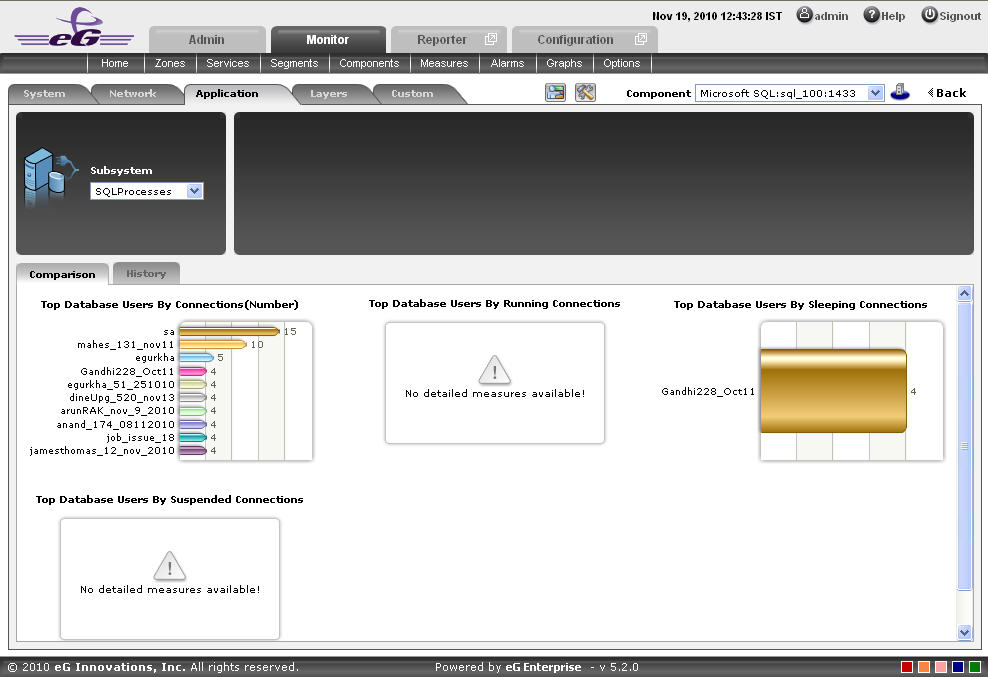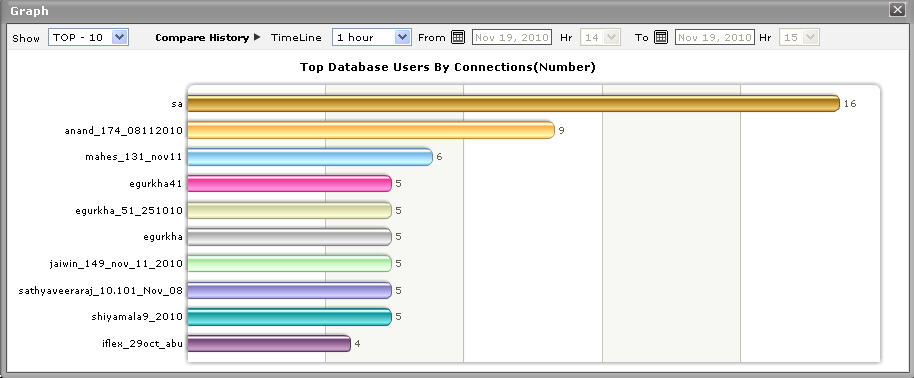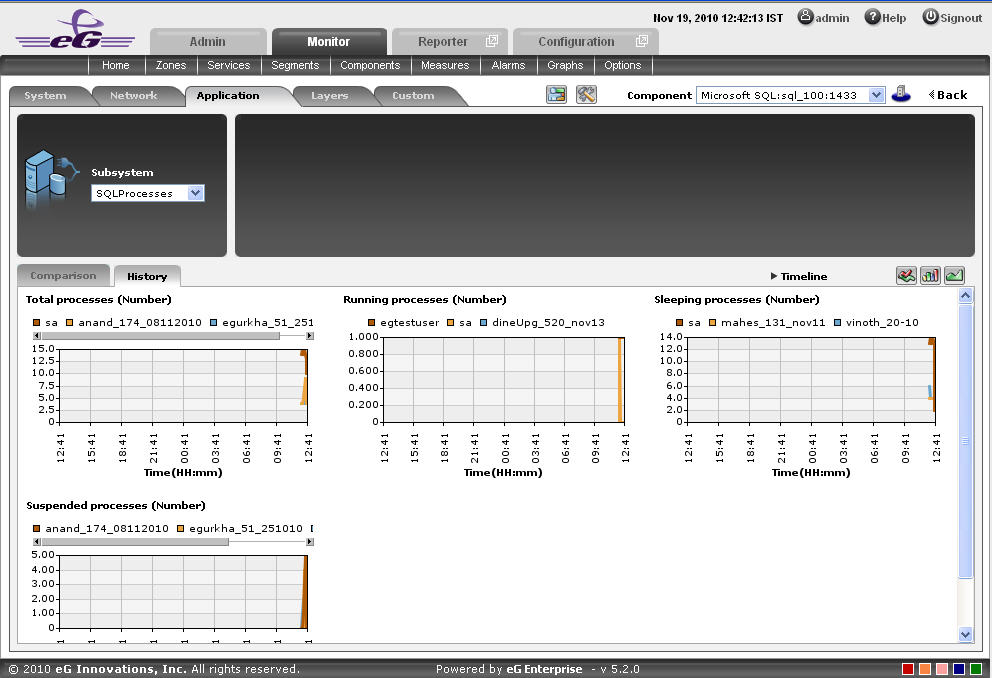SQLProcesses
Select the SQLProcesses option from the Subsystem list to know how efficiently the class loader used by the Java application is and has been loading/unloading classes onto memory. Upon selection, Figure 1 will appear.

Figure 1 : The Comparison tab page of the SQLProcesses Dashboard
The contents of this dashboard are as follows:
-
The Comparison tab page provides a series of top 10 charts, using which you can isolate the top Database Users for various resource-intensive processes. This default list of measures for top-n chart generation can be overridden by following the steps discussed below:
- Click on the
 icon at the top of the Application Dashboard. In the Dashboard Settings window that appears, select Application from the Module list, and SQLProcesses from the Sub-System list.
icon at the top of the Application Dashboard. In the Dashboard Settings window that appears, select Application from the Module list, and SQLProcesses from the Sub-System list. - To add new measures for which top-n graphs are to be displayed in the Comparison tab page, first, pick the Comparison Graph option from the Add/Delete Measures for list. Upon selection of this option, the pre-configured measures for comparison graphs will appear in the Existing Value(s) list.
- Next, select the Test that reports the said measure, pick the measure of interest from the Measures list, provide a Display name for the measure, and click the Add button to add the chosen measure to the Existing Value(s) list.
- If you want to delete one/more measures for which comparison graphs pre-exist in the Comparison tab page, then, as soon as you choose the Comparison Graph option from the Add/Delete Measures for list, pick any of the displayed measures from the Existing Value(s) list, and click the Delete button.
- Finally, click the Update button to register the changes.
Note:
Only users with Admin or Supermonitor privileges can enable/disable the system, network, and application dashboards, or can customize the contents of such dashboards using the Dashboard Settings window. Therefore, whenever a user without Admin or Supermonitor privileges logs into the monitoring console, the
 button will not appear.
button will not appear. - Click on the
-
To view the complete list of database users for each process, simply click on the corresponding graph in Figure 1. This enlarges the graph as depicted by Figure 2.

Figure 2 : The expanded Comparison graph in the SQLProcesses dashboard
- Though the enlarged graph lists the database users, by default, you can customize the enlarged graph to display the details of only a few of the best/worst-performing processes by picking a top-n or last-n option from the Show list in Figure 2.
- Another default aspect of the enlarged graph is that it pertains to the current period only. Sometimes however, you might want to know what occurred during a point of time in the past; for instance, while trying to understand the reason behind a sudden slowdown in a particular process on a particular day last week, you might want to first determine which process has behaved abnormally on the same day. To figure this out, the enlarged graph allows you to compare the historical performance of the processes. For this purpose, click on the Compare History link in Figure 2 and select the TimeLine of your choice.
- The History tab page below, by default, provides a series of measure graphs that reveal how the process has been performing over the default duration of the last 24 hours. If there is a sudden slowdown in the process, it could indicate that the server is experiencing issues with the concerned process. In such a case, a look at these measure graphs will help you figure out when exactly the bottleneck surfaced - did it happen suddenly or is it a condition that has become worse with time?
-
The default duration of 24 hours can be overridden using the procedure discussed below:
- Click on the
 icon at the top of the Application Dashboard.
icon at the top of the Application Dashboard. - In the Dashboard Settings window that appears, select History Graph from the Default Timeline for list.
- Then, choose a Timeline for the graph.
- Finally, click the Update button.
Note:
Only users with Admin or Supermonitor privileges can enable/disable the system, network, and application dashboards, or can customize the contents of such dashboards using the Dashboard Settings window. Therefore, whenever a user without Admin or Supermonitor privileges logs into the monitoring console, the
 button will not appear.
button will not appear. 
Figure 3 : Figure 3.56: The History tab page of the SQLProcesses dashboard
- Click on the
- If need be, you can even alter the timeline of all these measure graphs so that you can analyze performance across days and weeks; for this, simply click the Timeline link at the right, top corner of the History tab page and change the timeline for the graphs using the calendar that pops out. To change the timeline of a single graph alone, simply click on that graph to enlarge it, and then modify the Timeline of the graph in the enlarged mode. In the enlarged mode, you can even change the dimension of the measure graph (3d / 2d).
- To determine the service level achievements / slippages of the process, you need to view summary graphs of the measures and not the default measure graphs. For this, just click on the
 icon at the right, top corner of the History tab page.
icon at the right, top corner of the History tab page. -
The summary graphs reveal the percentage of time the process experienced problems in the database. Besides revealing the efficiency of your administrative staff in recognizing bottlenecks and mitigating them, these summary graphs also indicate whether the class loader has been able to maintain the assured performance levels during the default duration of 24 hours.
To override this default duration, follow the steps below:
- Click on the
 icon at the top of the Application Dashboard.
icon at the top of the Application Dashboard. - In the Dashboard Settings window that appears, select Summary Graph from the Default Timeline for list.
- Then, choose a Timeline for the graph.
- Finally, click the Update button.
- Click on the
- In case of the summary graphs too, you can change the Timeline of all graphs by clicking on the Timeline link at the right, top corner of the History tab page. To alter the timeline of a single graph, here again, you will have to click on that graph, enlarge it, and modify the timeline. Also, by default, hourly summaries are plotted in the summary graph; you can configure these graphs to plot daily/monthly summaries instead by picking the relevant option from the Duration list in the enlarged mode.
- To analyze past trends in the behavior of the processes, click on the
 icon at the right, top corner of the History tab page. These trend graphs, by default, plot the minimum and maximum values that every measure registered during each hour of the last 24 hours (by default). By carefully observing these past trends, you can effectively analyze the workload of the process, predict future workloads accordingly, and suggest measures to enhance the efficiency of the process. Here again, you can change the timeline of all graphs using the Timeline link, or just a particular graph by clicking on it and enlarging it.
icon at the right, top corner of the History tab page. These trend graphs, by default, plot the minimum and maximum values that every measure registered during each hour of the last 24 hours (by default). By carefully observing these past trends, you can effectively analyze the workload of the process, predict future workloads accordingly, and suggest measures to enhance the efficiency of the process. Here again, you can change the timeline of all graphs using the Timeline link, or just a particular graph by clicking on it and enlarging it. -
For changing the default duration (of 24 hours) of the trend graphs, do the following:
- Click on the
 icon at the top of the Application Dashboard.
icon at the top of the Application Dashboard. - In the Dashboard Settings window that appears, select Trend Graph from the Default Timeline for list.
- Then, choose a Timeline for the graph.
- Finally, click the Update button.
- Click on the
-
In addition, when a trend graph is enlarged, it is not just the Timeline that you can modify. The Duration of the graph can also be altered. By default, trend graphs reveal only the hourly trends in performance. By picking the relevant option from the Duration list, you can ensure that the trend graph in question plots daily/monthly trend values instead. Also, in the enlarged mode, the Graph type can also be modified. Since the default Graph type is Min/Max, the trend graph, by default, reveals the minimum and maximum values registered by a measure. If need be, you can select the Avg or Sum option from the Graph type list to plot average trend values of a measure or sum of trends (as the case may be) in the graph.
Note:
In case of descriptor-based tests, the Summary and Trend graphs displayed in the History tab page typically plot the values for a single descriptor alone. To view the graph for another descriptor, pick a descriptor from the drop-down list made available above the corresponding summary/trend graph.
- At any point in time, you can switch to the measure graphs by clicking on the
 button.
button. -
Typically, the History tab page displays measure, summary, and trend graphs for a default set of measures. If you want to add graphs for more measures to this tab page or remove one/more measures for which graphs pre-exist in this tab page, then, do the following:
- Click the
 button at the top of the dashboard.
button at the top of the dashboard. - The Dashboard Settings window then appears. From the Module list of Figure 20, pick Application, choose SQLProcesses as the Sub-System, and then, select History Graph from the Add/Delete Measures for list.
- The measures for which graphs pre-exist in the History tab page will be automatically displayed in the Existing Value(s) list. To delete a measure, and in effect, its corresponding graph as well, select the measure from the Existing Value(s) list, click the Delete button, and then click the Update button.
- To add a new graph, first, pick the Test that reports the measure for which a graph is to be generated.
- Next, select the Measure of interest.
- Provide a Display name for the measure. Then, click the Add button to add the measure to the Existing Values(s) list. Finally, click the Update button.
- This will add a new measure, summary, and trend graph for the chosen measure to the History tab page.
Note:
Only users with Admin or Supermonitor privileges can enable/disable the system, network, and application dashboards, or can customize the contents of such dashboards using the Dashboard Settings window. Therefore, whenever a user without Admin or Supermonitor privileges logs into the monitoring console, the
 button will not appear.
button will not appear. - Click the